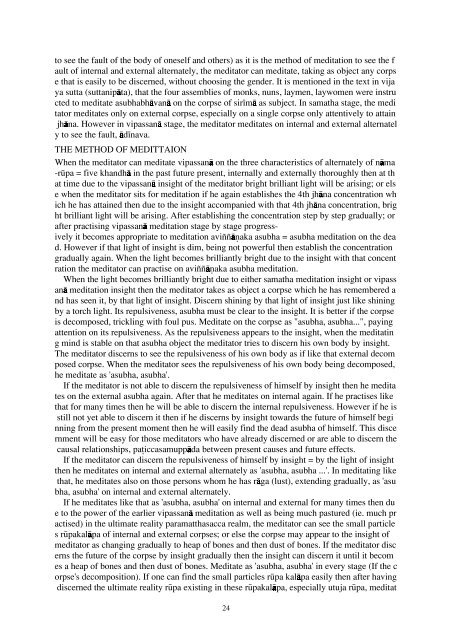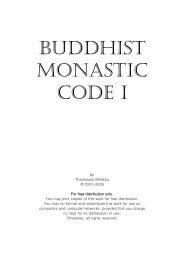Vipassana Kammatthana.pdf
Vipassana Kammatthana.pdf
Vipassana Kammatthana.pdf
Create successful ePaper yourself
Turn your PDF publications into a flip-book with our unique Google optimized e-Paper software.
to see the fault of the body of oneself and others) as it is the method of meditation to see the f<br />
ault of internal and external alternately, the meditator can meditate, taking as object any corps<br />
e that is easily to be discerned, without choosing the gender. It is mentioned in the text in vija<br />
ya sutta (suttanipåta), that the four assemblies of monks, nuns, laymen, laywomen were instru<br />
cted to meditate asubhabhåvanå on the corpse of sir¥må as subject. In samatha stage, the medi<br />
tator meditates only on external corpse, especially on a single corpse only attentively to attain<br />
jhåna. However in vipassanå stage, the meditator meditates on internal and external alternatel<br />
y to see the fault, åd¥nava.<br />
THE METHOD OF MEDITTAION<br />
When the meditator can meditate vipassanå on the three characteristics of alternately of nåma<br />
-rËpa = five khandhå in the past future present, internally and externally thoroughly then at th<br />
at time due to the vipassanå insight of the meditator bright brilliant light will be arising; or els<br />
e when the meditator sits for meditation if he again establishes the 4th jhåna concentration wh<br />
ich he has attained then due to the insight accompanied with that 4th jhåna concentration, brig<br />
ht brilliant light will be arising. After establishing the concentration step by step gradually; or<br />
after practising vipassanå meditation stage by stage progressively<br />
it becomes appropriate to meditation aviññåˆaka asubha = asubha meditation on the dea<br />
d. However if that light of insight is dim, being not powerful then establish the concentration<br />
gradually again. When the light becomes brilliantly bright due to the insight with that concent<br />
ration the meditator can practise on aviññåˆaka asubha meditation.<br />
When the light becomes brilliantly bright due to either samatha meditation insight or vipass<br />
anå meditation insight then the meditator takes as object a corpse which he has remembered a<br />
nd has seen it, by that light of insight. Discern shining by that light of insight just like shining<br />
by a torch light. Its repulsiveness, asubha must be clear to the insight. It is better if the corpse<br />
is decomposed, trickling with foul pus. Meditate on the corpse as "asubha, asubha...", paying<br />
attention on its repulsiveness. As the repulsiveness appears to the insight, when the meditatin<br />
g mind is stable on that asubha object the meditator tries to discern his own body by insight.<br />
The meditator discerns to see the repulsiveness of his own body as if like that external decom<br />
posed corpse. When the meditator sees the repulsiveness of his own body being decomposed,<br />
he meditate as 'asubha, asubha'.<br />
If the meditator is not able to discern the repulsiveness of himself by insight then he medita<br />
tes on the external asubha again. After that he meditates on internal again. If he practises like<br />
that for many times then he will be able to discern the internal repulsiveness. However if he is<br />
still not yet able to discern it then if he discerns by insight towards the future of himself begi<br />
nning from the present moment then he will easily find the dead asubha of himself. This disce<br />
rnment will be easy for those meditators who have already discerned or are able to discern the<br />
causal relationships, pa iccasamuppåda between present causes and future effects.<br />
If the meditator can discern the repulsiveness of himself by insight = by the light of insight<br />
then he meditates on internal and external alternately as 'asubha, asubha ...'. In meditating like<br />
that, he meditates also on those persons whom he has råga (lust), extending gradually, as 'asu<br />
bha, asubha' on internal and external alternately.<br />
If he meditates like that as 'asubha, asubha' on internal and external for many times then du<br />
e to the power of the earlier vipassanå meditation as well as being much pastured (ie. much pr<br />
actised) in the ultimate reality paramatthasacca realm, the meditator can see the small particle<br />
s rËpakalåpa of internal and external corpses; or else the corpse may appear to the insight of<br />
meditator as changing gradually to heap of bones and then dust of bones. If the meditator disc<br />
erns the future of the corpse by insight gradually then the insight can discern it until it becom<br />
es a heap of bones and then dust of bones. Meditate as 'asubha, asubha' in every stage (If the c<br />
orpse's decomposition). If one can find the small particles rËpa kalåpa easily then after having<br />
discerned the ultimate reality rËpa existing in these rËpakalåpa, especially utuja rËpa, meditat<br />
24






